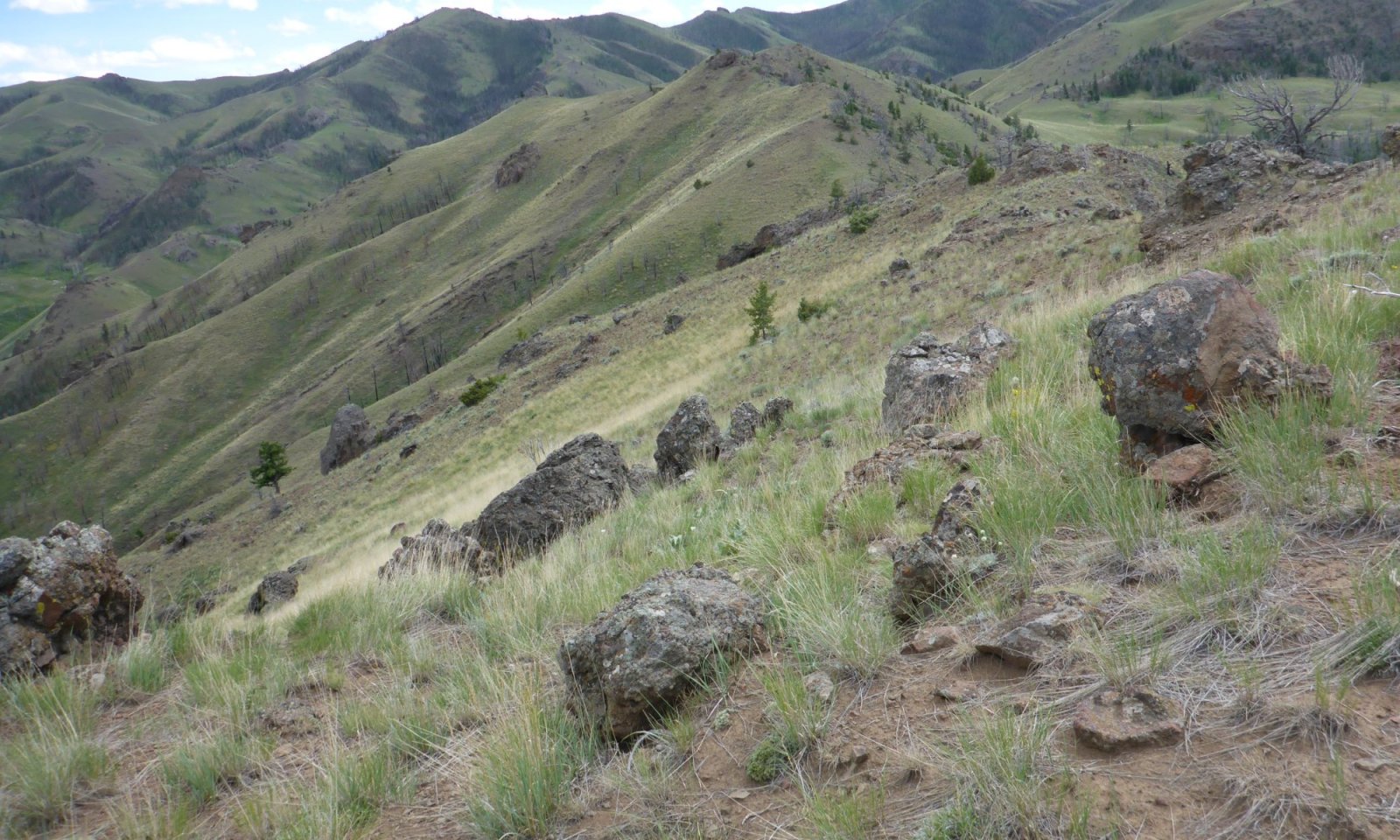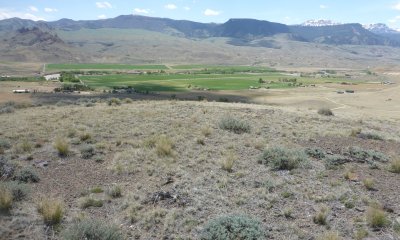
Igneous (Ig) Absaroka Lower Foothills
Scenario model
Current ecosystem state
Select a state
Management practices/drivers
Select a transition or restoration pathway
-
Transition T1A
Frequent and severe grazing (yearlong grazing) or compaction from surface traffic, will weaken the mid-stature grasses and allow threadleaf sedge to increase.
More details -
Transition T1B
Disturbance to the soil surface provides the opportunity for invasive species to find their niche in a community.
More details -
Transition T2A
Drought with or without hoof impact or mechanical soil impact to displace the sod opens the niche for invasive species to establish.
More details -
Transition T4A
Any disturbance to or failure in reclaiming the community leaves this State at risk to invasion.
More details -
No transition or restoration pathway between the selected states has been described
Target ecosystem state
Select a state
State 1
Perennial Grasses/Shrubs



Description
The Perennial Grasses/Shrubs State (State 1) is the reference state for the Igneous ecological site. The prominent cover of bluebunch wheatgrass, king-spike fescue and other mid-stature cool-season bunchgrasses with perennial forbs and a mix of black sagebrush, Wyoming big sagebrush, and fringed sagewort make for a productive and stable site.
Characteristics and indicators
Bluebunch wheatgrass is the dominant herbaceous species on this site, shrubs are less prominent on this landscape, but are found scattered within the community. Sagebrush cover will vary across this site in response to underlying geology. In limestone interbeds black sagebrush is the dominant woody cover, and in sedimentary interbeds Wyoming big sagebrush prevails.
Resilience management
The hardiness of the vegetation that thrive within the harsh conditions of the soil characteristics of the Igneous ecological site create a plant community resistant to change. But once disturbed, the herbaceous component of this site is difficult to restore, reducing the resiliency of the community.
Submodel
Description
The Sod-former/Sagebrush ecological site is a low-stature community that has shifted from the cool-season bunchgrasses to tillering grass-likes (threadleaf sedge). Fringed sagewort and pricklypear cactus are common.
Characteristics and indicators
The prominent cover is threadleaf sedge. Scattered sagebrush may persist with rubber rabbitbrush and skunkbush sumac. Season of use and species of grazing ungulate will be a factor affecting this cover. The sagebrush cover is dwarfed or droughty in appearance and is reduced in vigor by the shift in hydrology of this community. Most other mid-stature cool-season bunchgrasses are limited to within the canopy of the sagebrush or within the protective cactus clumps.
Resilience management
The dense root map of threadleaf sedge makes this community extremely resistant to change, and resilient to disturbance. Although the establishment of threadleaf sedge is a slow process, it will recover with time.
Removal of grazing or disturbance does not provide a shift in the herbaceous cover within this community. The overall health and vigor of both the herbaceous as well as woody cover will improve with the removal of the grazing pressure or disturbance from the community.
Submodel
Description
Cheatgrass or downy brome (Bromus tectorum) is an aggressive annual invader that threatens rangelands across the west, including Wyoming. The ability of cheatgrass to persist through the winter under a blanket of snow and grow early allow it to take advantage of early spring precipitation and snowmelt (winter annual). Multiple growth cycles throughout a year leaves a thick litter (duff) layer and builds a significant seedbank. This annual invader has an aggressive growth habit that creates a hostile environment for most native species, including sagebrush. Climatic shifts, changes in management, and exposure to human activity are a few of the explanations for the current flush and rapid expanse across the western United States.
Although cheatgrass is the most prevalent large-scale threat for rangeland managers, a variety of thistles, in combination with other aggressive invaders such as toadflax are increasing in density and frequency. Each species produces their own set of challenging management issues. As new species are identified, or as other species become more prevalent on a large-scale, the community dynamics in this State will shift in response to the concerns of the identified species.
Characteristics and indicators
This State is characterized by the presence and then dominance of invasive/non-native species. The competitive nature of annuals and other invasive species, creates a complex environment that inhibits control, and makes it implausible to attain complete eradication once an invasive species has established on the landscape. Increased access, increased travels of individuals, and other natural and man-made disturbances has opened the door for invasion in most native communities.
Resilience management
The lack of tools to achieve complete eradication, and variable success on long-term reduction of most invasive species has led to this State being resilient and resistant to change. The shallow depth, slope, and access to these areas limit the ability and cost effectiveness to treat. Mechanical means to treat invasions are generally not recommend, and so not transition to a disturbed condition is modeled. However, under select circumstances, mining and other human activities including wildfire may create such a transition.
Submodel
Description
Disturbance to these highly erodible soils (whether it was mechanical, cultural, or natural) reduced the resilience or resistance to support native vegetation or the ability to respond to management in the same manner as an undisturbed site. Changes to soil structure and hydrologic processes reduce the stability and ability to recover. Reclamation or restoration of an area is limited or restrictive due to slope, access, and lack of depth to bedrock. These "altered" lands may, after significant inputs and time, resemble the Reference Communities (1.1 or 1.2), but they will not respond or function the same as the Reference State.
One catastrophic event or several smaller disturbances can lead to the transition to the Altered State from any identified state within the State-and-Transition Model. The soils have not been altered to the extent that they are outside the site characteristics, but the potential has shifted enough that it will not respond like the Reference State.
The time required to allow the redevelopment of structure and the cryptogrammic crust is beyond the natural function of management. The initial flush of vegetation is annual forbs, including mustards, a successional plant community. The site begins its own recovery, but the time required to return to the original conditions (pre-disturbance) can be extensive. The site, however, may become similar in composition to the Reference State.
Characteristics and indicators
The Disturbed State is characterized by a landscape that has had significant soil disturbance. Early successional plant communities, evidence of mining, or the presence of introduced species (crested wheatgrasses, russian wildrye, etc.) are indicators of this State.
Resilience management
Stabalization and preservation of as much soil as possible is the mechanism to provide resiliency to this State. The use of mulch or other slope stabilization materials will help in reducing erosional impact and allowing vegetation to establish.
Submodel
Mechanism
Frequent and severe (year-long or continuous season-long ) grazing or compaction from surface traffic, will convert the plant community to a Threadleaf Sedge Sod Plant Community. The impact to of frequent or repeated hits during grazing, hoof impact, and lack of rest for recovery weakens and removes the key grass species in the community. As the mid-stature grasses decline, threadleaf sedge is able to increase and alter the hydrology of the site.
Constraints to recovery
The dense root mat formed by threadleaf sedge alters the hydrology, effectively removing moisture from the site, limiting the available resources for other native species. The dense sod also limits the available soil space for seedling establishment. Interpspaces between sod patches are prone to erosion and runoff (limited infiltration of moisture).
Mechanism
Drought, soil disturbances, or high-intensity grazing with a seed source present can open the soil surface and weaken the community allowing invasive species to establish. Although not common, fire can provide the niche for cheatgrass to establish on this site.
Constraints to recovery
Once invasive species, especially cheatgrass, establish, it is costly and difficult (if even possible) to remove. The lack of the key grass species also limits recover of this site.
Mechanism
Drought, or drought with grazing intensity together, weakens a water limited system allowing invasive species the opportunity to take advantage of the limited moisture. Threadleaf sedge has been seen to die back or die out with prolonged drought opening the canopy and the community’s vulnerability to invasive species. Disturbance by mechanical means or human activities that break the root masses or disturb the soil surface open this closed community to potential invasive species, especially when there is a readily available seed source for those invasive species.
Constraints to recovery
The sod of threadleaf sedge will continue to impact the hydrology and competition for limited resources in this community limiting the potential for recovery. The lack of other key herbaceous species also is a constraint on this site. The inability, at this time, to eradicate cheatgrass does not allow for a complete recovery of an invaded community.
Mechanism
Any disturbance that occurs or stress that is placed on the herbaceous cover, weakens the canopy and allows for invasive species to establish if a seed source is present. This State is at high risk of transitioning to an Invaded State. The challenge of successful seedings on a very shallow soils and steep slopes leaves the community vulnerable to invasion.
Constraints to recovery
The challenge of eradicating or reducing invasive species such as cheatgrass prevents recovery of most invaded communities without significant inputs for weed control, seeding with long-term grazing management.
Model keys
Briefcase
Add ecological sites and Major Land Resource Areas to your briefcase by clicking on the briefcase (![]() ) icon wherever it occurs. Drag and drop items to reorder. Cookies are used to store briefcase items between browsing sessions. Because of this, the number of items that can be added to your briefcase is limited, and briefcase items added on one device and browser cannot be accessed from another device or browser. Users who do not wish to place cookies on their devices should not use the briefcase tool. Briefcase cookies serve no other purpose than described here and are deleted whenever browsing history is cleared.
) icon wherever it occurs. Drag and drop items to reorder. Cookies are used to store briefcase items between browsing sessions. Because of this, the number of items that can be added to your briefcase is limited, and briefcase items added on one device and browser cannot be accessed from another device or browser. Users who do not wish to place cookies on their devices should not use the briefcase tool. Briefcase cookies serve no other purpose than described here and are deleted whenever browsing history is cleared.
Ecological sites
Major Land Resource Areas
The Ecosystem Dynamics Interpretive Tool is an information system framework developed by the USDA-ARS Jornada Experimental Range, USDA Natural Resources Conservation Service, and New Mexico State University.


